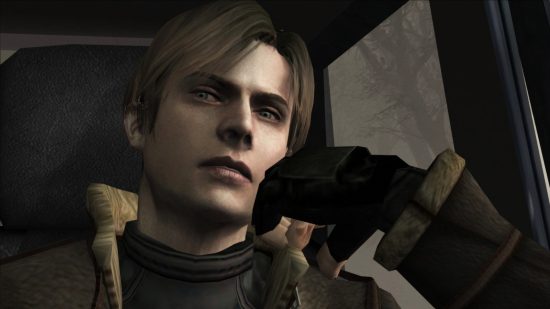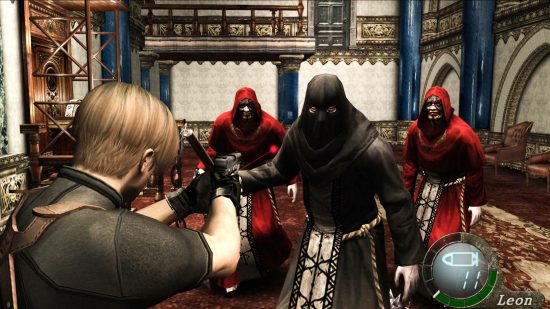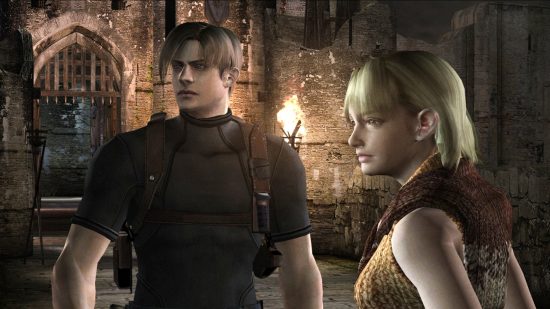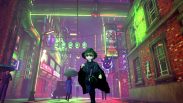Resident Evil 4 is one of the most successful horror games of all time. In fact, not only do many consider it to be the best Resident Evil game, but the best survival horror game out there, and given the strong competition it has from its own franchise, never mind other titles such as Silent Hill, that’s a huge accolade. However, the history of this iconic title may come as a surprise, and with the recent release of the Resident Evil 4 Remake, there’s no better time to dive in.
Capcom released the original Resident Evil 4 back in 2005 to critical acclaim and an excellent reception from fans, a fact that you likely already know. But what if I told you that RE4 went through numerous development hells before we got to go with Leon S Kennedy to rescue Ashley Graham from a remote European village? Actually, what if I up the ante and tell you that while a few ideas were scrapped and the team had to return to the drawing board, one resulted in a brand new IP?
Initially, Capcom conceived Devil May Cry as Resident Evil 4, but as we all know, that’s not what came to be. Instead, the game showed such promise in a different way to that of Resident Evil that the developers couldn’t help but explore what it could be, a decision that’s responsible for yet another classic series of games.
Honestly, not only did Capcom benefit from this, but so did players worldwide. Sure, Devil May Cry hit the market in 2001, four years before we’d get Resident Evil 4, but it was the right call by Shinji Mikami, the creator of Resident Evil. RE4 entered production in 1999 for the PlayStation 2 (following yet another successful venture with Resident Evil 3), with Hideki Kamiya serving as director.
What makes the original production of Resident Evil 4 so baffling is that Resident Evil 2 writer Noboru Sugimura created the story, though, at Kamiya’s behest, Sugimura made it “cool” and “stylish,” with some guy called Tony serving as the main protagonist. He was to be invincible, exceedingly smart, and riddled with biotechnology – does this sound like Resident Evil to you?
Mikami felt that the direction the project was going in moved too far away from the essence of Resident Evil. It’s those feelings that led to the series creator deeming the project unfit to be Resident Evil 4, though the game clearly showed promise as a fresh IP, and the success of Devil May Cry and its subsequent games is a testament to that. So, with the initial project being spun into a fresh series, it was time to restart development on RE4. Numerous people tried their hand at directing the game, with Hiroshi Shibata taking the reins for what would be dubbed the “fog” version.
While this iteration of Resident Evil 4 wouldn’t fully come to fruition, it did feature a castle (though it belonged to Umbrella), was set in Europe, and featured Leon. However, while those elements remained, minus Umbrella, factors such as Leeon having a hidden power in his left hand following an infection were left on the cutting room floor. Also, there was a different girl present in this version, though Capcom never revealed her to the public, so I can’t say if she’s as annoying as Ashley. My gut tells me no. Nobody is as irritating as the President’s daughter.
Well, that version wasn’t meant to be, and so we move on to the “hook man” version of Resident Evil 4. In a nutshell, Resident Evil’s Leon finds himself inside a dilapidated haunted building where the poor lad picks up yet another infection. Oh, and he has to fight ghosts. You see, this story has paranormal elements as opposed to zombies, an intriguing concept that I’m almost disappointed we didn’t get to experience. But then I play Resident Evil 4, and I don’t mind as much. Still, I’d be happy to see some full-on paranormal stuff in the Resident Evil universe one day.
Another disappointing change was the dialogue choices. You see, the hook man version of Resident Evil 4 included dialogue choices, which in theory, could mean that some decisions you made would have impacted the story, but alas, we’ll never know. So, onto the “hallucination” version of Resident Evil 4, the final concept to hit the cutting room floor. This one is the brainchild of Yasuhisa Kawamura (the scenario writer from Resident Evil 3: Nemesis), but he only got so far as a basic story concept for Resident Evil 4. While it certainly sounds like an interesting time, Capcom had to scrap it due to costs and being too formulaic. Still, it did involve a castle, Leon, zombies, and a girl, so we’re nearly there at this point.
In the end, none of the RE4 attempts could come close to what Mikami wanted, and so the iconic game developer took on the directional duties himself. By the time there was a clear direction for the game that would go on to achieve legendary status, it was no longer for the PlayStation 2 (though DMC honoured that agreement). Instead, Capcom and Nintendo announced Resident Evil 4 as one of the Capcom five – these are five GameCube exclusives by Capcom. Besides RE4, the Japanese publisher put P.N.03, Viewtiful Joe, Dead Phoenix, and Killer7 on the platform.
Evidently, the choice to include Resident Evil 4 in that lineup proved beneficial for Nintendo and its console, as RE4 claimed victory at the Game of the Year awards in 2005. Unsurprisingly, thanks to its momentous success, Capcom ported the survival horror gem to other platforms, including the Nintendo Wii (arguably the best version of the game, and perhaps one day, I’ll tell you why), PlayStation 2, PlayStation 4, Xbox One, and Nintendo Switch.
Porting the game to other platforms proves to be a good move from Capcom, as the game shifts more than 11 million units – an impressive figure that few releases can match. However, it’s not just monetary and critical success. It’s yet another Capcom game that would go on to influence the entirety of the survival horror genre. The original Resident Evil helped to bring survival horror to a mainstream audience, serving as a godfather to the genre, while Resident Evil 4 represents its evolution.
RE4 utilises an over-the-shoulder third-person view, a gameplay choice that wasn’t overly popular back in 2005, but Capcom changed the videogame landscape once again as this gameplay approach would become more and more popular. Not just in the world of horror either, but shooters and action games as well (Gears of War, anyone?), though if you want to see its influence in horror games Dead Space and a little game called The Last of Us are good examples, though I highly doubt you’ve heard of the last one. It’s not like it just had a hugely popular TV adaptation with The Last of Us season two on the way or anything.
So, you see, while the end product is a legendary videogame that continues to influence other titles to this day, it had a turbulent time while in development, with an array of iterations scrapped, the first of which led to the creation of another iconic franchise in Devil May Cry. While it’s a shame that certain elements, such as dialogue choices and exploration of the paranormal, couldn’t make the cut, I can’t deny that it was the right decision. The legacy of Resident Evil 4 speaks for itself, and with the new Resident Evil 4 Remake, even more people can experience the greatness.
All that’s left to say is, go on. Go. It’s time to travel to Europe, explore a strange village, find an annoying girl, save the day, and kick some ass as the one and only Leon S. Kennedy. Oh, and for even more interesting history lessons from PT, check out our Phoenix Wright: Ace Attorney history and Castlevania: Bloodlines history articles.
















